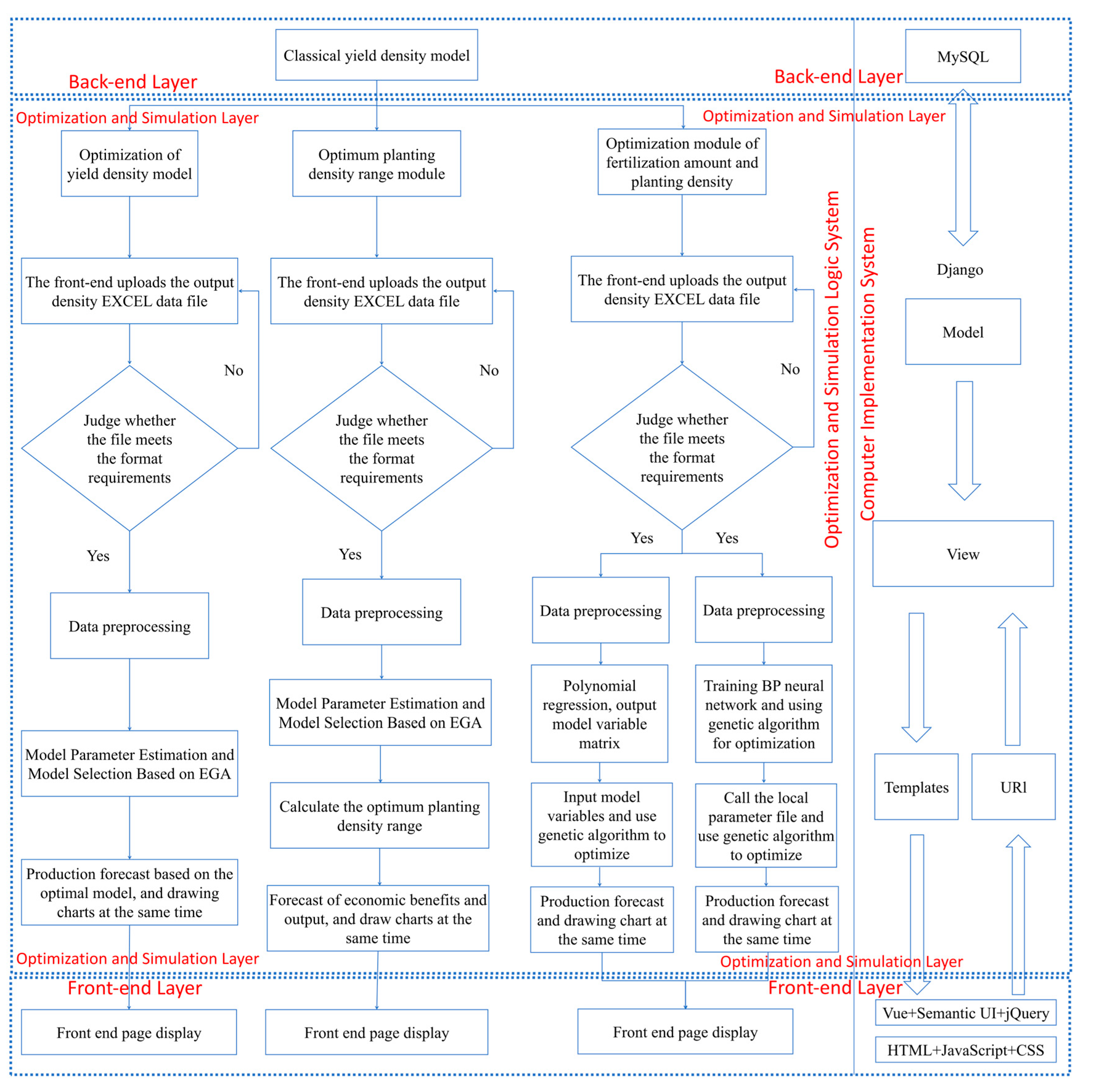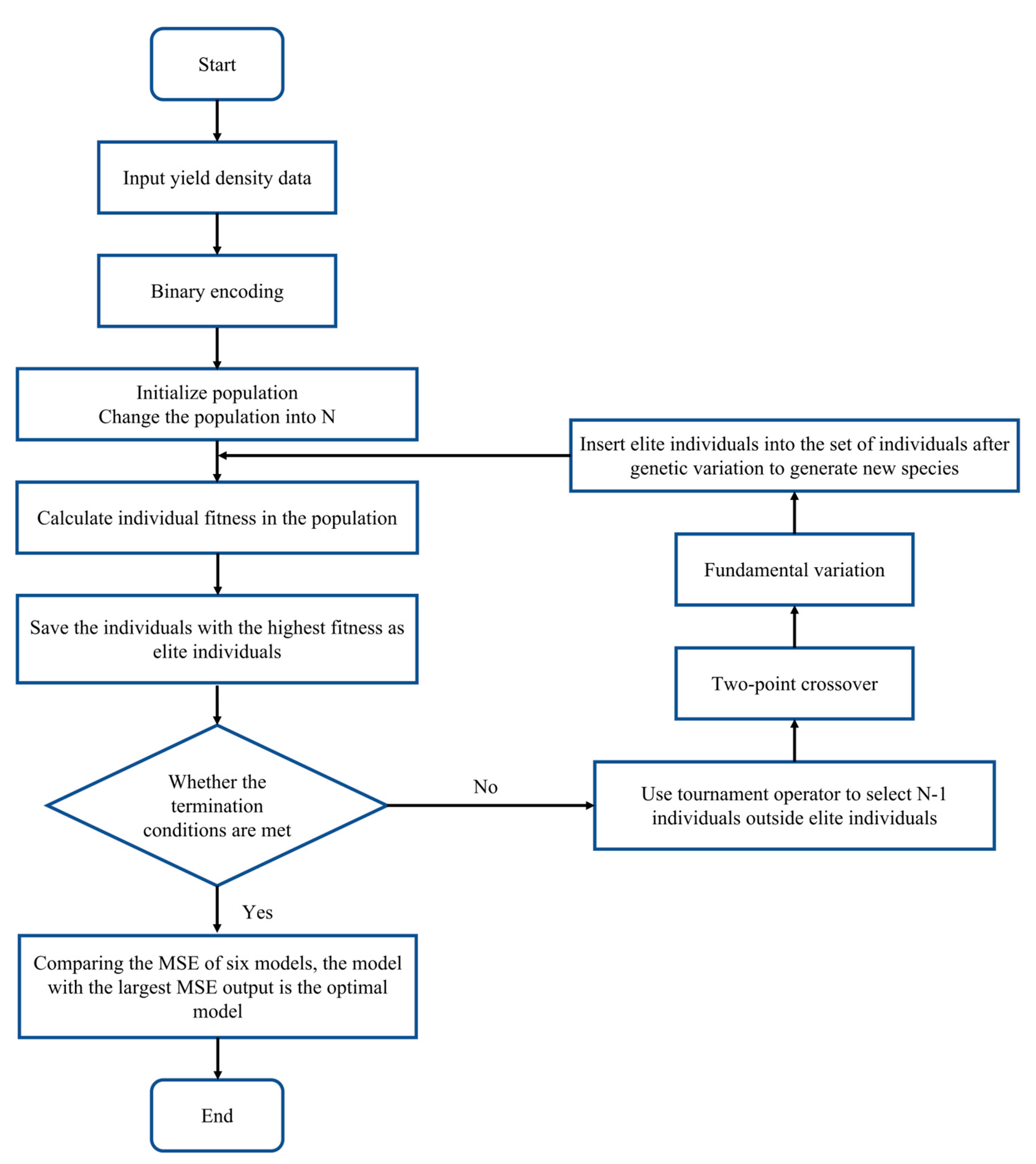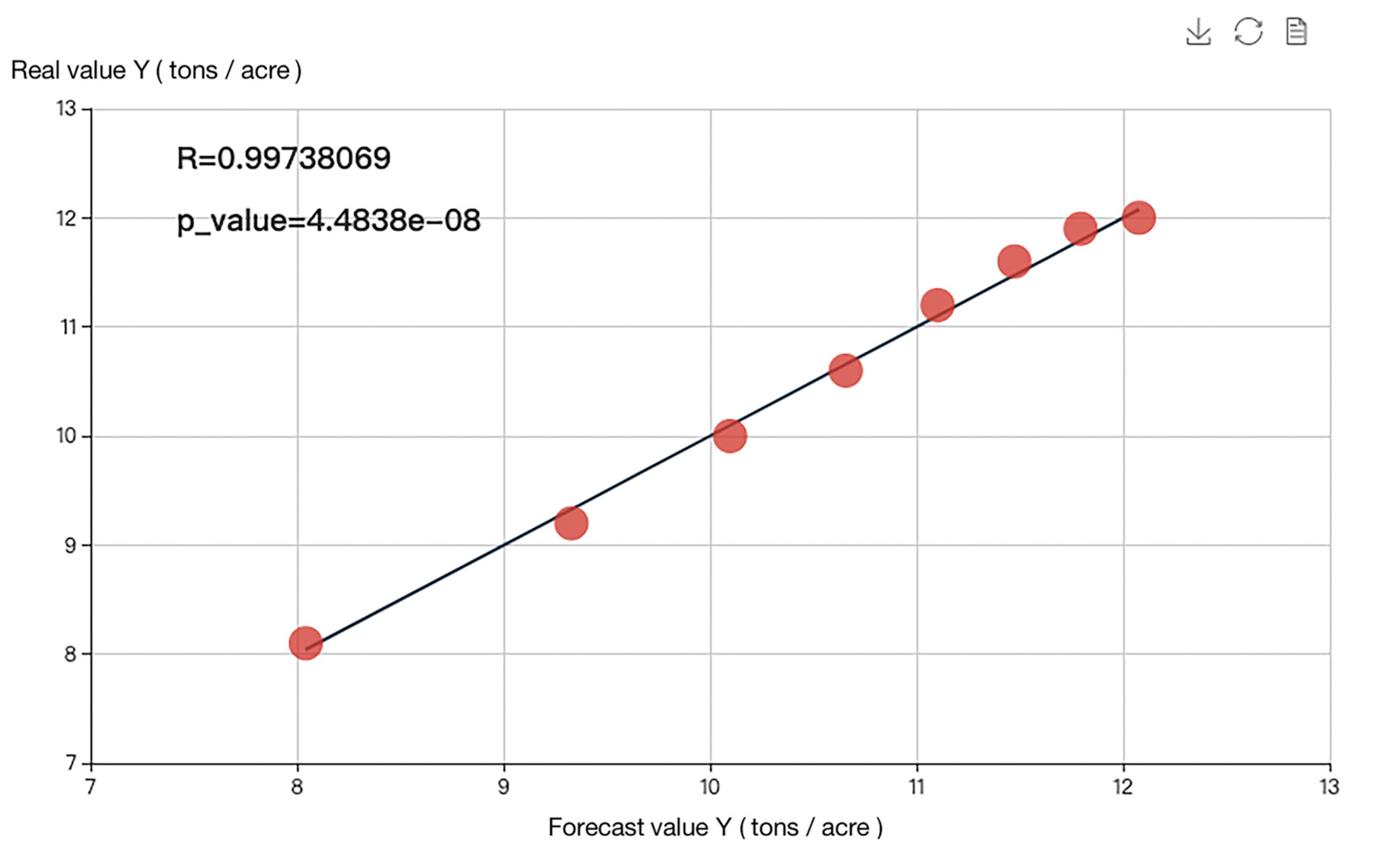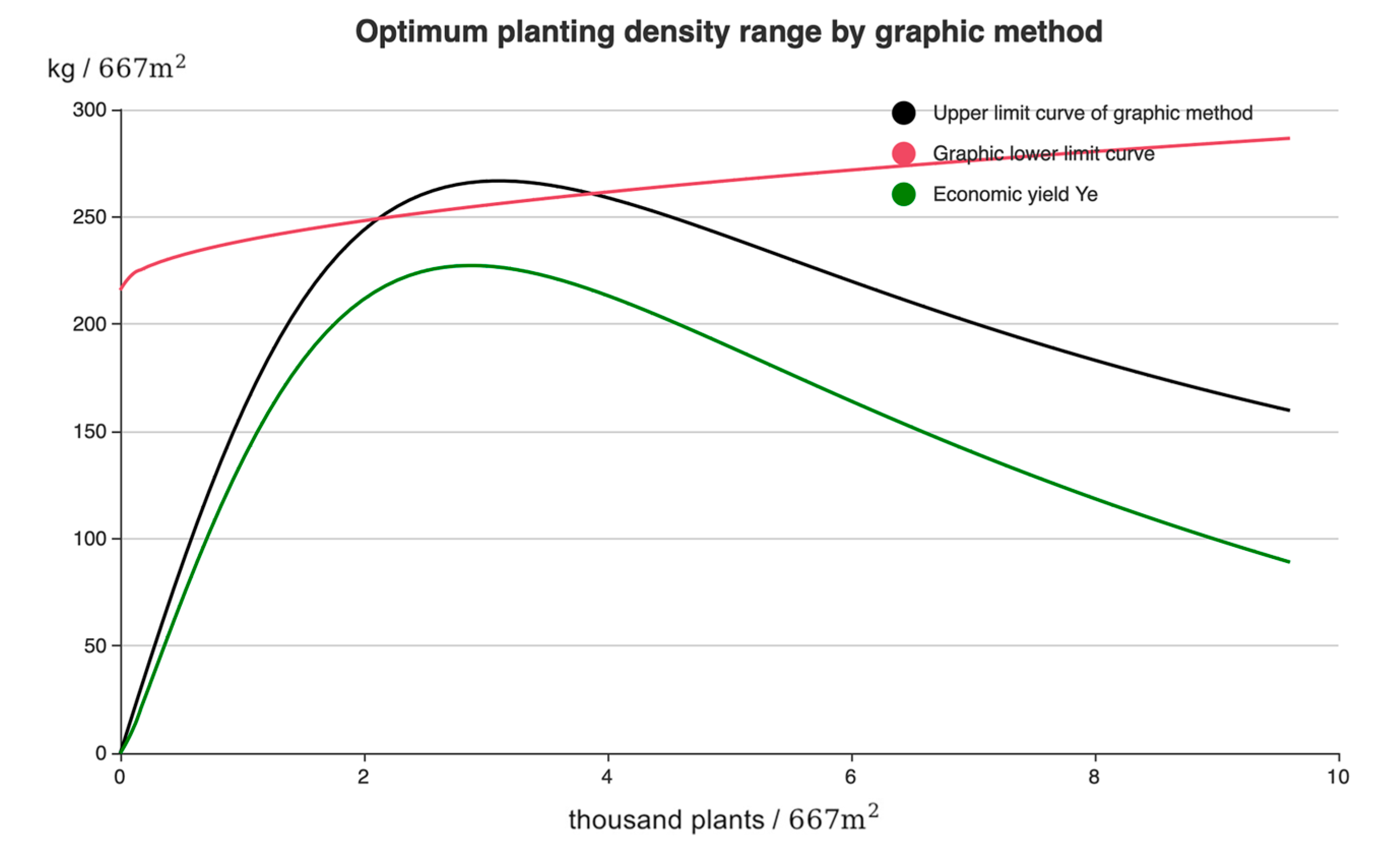CPDOS: A Web-Based AI Platform to Optimize Crop Planting Density
Abstract
:1. Introduction
2. Materials and Methods
2.1. Overview of Methods
- (1)
- Crop planting density optimization method
- (2)
- Implementation of CPDOS
2.2. Experimental Data
2.2.1. Potato Yield–Density Data
2.2.2. Maize Yield–Density Data
2.2.3. Soybean Yield–Density Data
2.2.4. Yield–Density Data of Different Crops
2.3. Technical Route
2.4. Running CPDOS
- (1)
- The user can obtain the yield–density equation of different crops under different environments by inputting the yield–density data and understanding the change rule between individual yield and population yield under different densities.
- (2)
- By inputting the production cost, planting density, and yield data, the user can obtain the optimal yield–density equation matching the current data, and the best economic yield can be obtained.
- (3)
- Users input the planting density, fertilization data, and yield data. The system performs quadratic polynomial regression and BP neural network regression, respectively, and obtains the best planting density and fertilization ratio in each regression model.
- (4)
- Data visualization is realized and the yield–density curve and the model’s goodness-of-fit verification diagram are drawn to better display the calculated results.
2.5. Crop Yield–Density Model for CPDOS
2.5.1. Progressive Yield–Density Model
2.5.2. Parabolic Yield–Density Model
2.5.3. Mixed Yield–Density Model
2.6. CPDOS Parameter Estimation of Yield–Density Model and Selection of Optimal Yield–Density Model Based on EGA (Evolutionary Genetic Algorithm)
2.6.1. CPDOS Genetic Algorithm EGA Strategy Design
- (1)
- Coding population initialization
- (2)
- Population initialization
- (3)
- Set the fitness function
- (4)
- Selection strategy
- (5)
- Cross strategy
- (6)
- Variation operation
- (7)
- Elite retention strategy
- (8)
- Model screening
2.6.2. Parameter Estimation of Yield–Density Model and Selection of Optimal Yield Density Model
2.7. CPDOS Solves the Optimum Planting Density Range for the Highest Economic Benefit of Crops
2.7.1. Economic Benefit Yield of CPDOS Crops
2.7.2. Solution Method of Optimum Planting Density Range for Highest Economic Benefit of Crops
- (1)
- Determining the economic yield–density model
- (2)
- The optimum planting density range double-intersection equation
- (3)
- Dichotomy for solving intersection equation
2.8. Optimization of Fertilization Ratio of Planting Density for Maximum Crop Yield by CPDOS
2.8.1. BP Neural Network Structure Design of CPDOS
- (1)
- Network layer design
- (2)
- The node number design of each layer
2.8.2. Data Normalization Processing
2.8.3. Cross-Validation
2.8.4. The Realization of BP Neural Network
- (1)
- The neural network model structure is determined to be a three-layer BP neural network. The activation functions of the hidden layer and the output layer are Sigmoid functions, and the number of hidden layer neurons is 8.
- (2)
- Use the KFold method in Sklearn to implement K-fold verification, and the K value is set to 5.
- (3)
- Normalize the input data, the normalized interval is .
- (4)
- Setting the model training parameters: using the batch gradient descent method, set the batch size to 10; set the loss function as the mean square error MSE of the predicted value and the true value. Using the Adam optimization method, the initial learning rate is found to be 0.1; set the maximum number of iterations to 10,000; the training termination condition is that the average prediction error of 5 test sets for the maximum number of iterations or cross-validation is less than 0.0002.
- (5)
- BP neural network training, output the best model.
3. Results
3.1. CPDOS Optimal Yield–Density Model
3.2. The CPDOS Optimum Planting Density Range
3.3. Optimum Fertilization Ratio of Planting Density for CPDOS
3.4. Optimal Yield–Density Model for Different Crops
4. Discussion
4.1. Adaptability of Six CPDOS Classical Yield–Density Models to Crop Species
4.2. Having Additional Comprehensive Crop Production Data Is an Important Basis for Improved CPDOS
4.3. The CPDOS System Still Has Significant Room for Improvement
5. Conclusions
Supplementary Materials
Author Contributions
Funding
Data Availability Statement
Conflicts of Interest
References
- Lv, X. Review of mid-and long-term predictions of China’s grain security. China Agric. Econ. Rev. 2013, 5, 567–582. [Google Scholar] [CrossRef]
- Chen, Y.; Li, X.; Wang, J. Changes and effecting factors of grain production in China. Chin. Geogr. Sci. 2011, 21, 676–684. [Google Scholar] [CrossRef]
- Khan, A.; Najeeb, U.; Wang, L.; Tan, D.K.Y.; Yang, G.; Munsif, F.; Ali, S.; Hafeez, A. Planting density and sowing date strongly influence growth and lint yield of cotton crops. Field Crops Res. 2017, 209, 129–135. [Google Scholar] [CrossRef]
- Willey, R.W.; Heath, S.B. The quantitative relationships between plant population and crop yield. Adv. Agron. 1969, 21, 281–321. [Google Scholar] [CrossRef]
- Holliday, R. Plant population and crop yield. Nature 1960, 186, 22–24. [Google Scholar] [CrossRef]
- Shinozaki, K. Intraspecific competition among higher plants. VII. Logistic theory of the CD effect. J. Inst. Polytech. Osaka City Univ. Ser. 1956, 7, 35–72. [Google Scholar]
- Fang, X.; Li, Y.; Nie, J.; Wang, C.; Huang, K.; Zhang, Y.; Zhang, Y.; She, H.; Liu, X.; Ruan, R.; et al. Effects of nitrogen fertilizer and planting density on the leaf photosynthetic characteristics, agro-nomic traits and grain yield in common buckwheat (Fagopyrum esculentum M.). Field Crops Res. 2018, 219, 160–168. [Google Scholar] [CrossRef]
- Zhou, C.; Huang, Y.; Jia, B.; Wang, Y.; Wang, Y.; Xu, Q.; Li, R.; Wang, S.; Dou, F. Effects of cultivar, nitrogen rate, and planting density on rice-grain quality. Agronomy 2018, 8, 246. [Google Scholar] [CrossRef]
- Tang, K.; Struik, P.; Yin, X.; Calzolari, D.; Musio, S.; Thouminot, C.; Bjelková, M.; Stramkale, V.; Magagnini, G.; Amaducci, S. A comprehensive study of planting density and nitrogen fertilization effect on dual-purpose hemp (Cannabis sativa L.) cultivation. Ind. Crops Prod. 2017, 107, 427–438. [Google Scholar] [CrossRef]
- Shahzadi, R.; Ferzund, J.; Tausif, M.; Suryani, M.A. Internet of things based expert system for smart agriculture. Int. J. Adv. Comput. Sci. Appl. 2016, 7, 341–350. [Google Scholar] [CrossRef]
- Hu, X.; Qian, S. IoT application system with crop growth models in facility agriculture. In Proceedings of the 2011 6th International Conference on Computer Sciences and Convergence Information Technology (ICCIT), Seogwipo, Republic of Korea, 29 November–1 December 2011; pp. 129–133. [Google Scholar]
- Mo, H. Planting density and crop yield-an analysis of quantitative relationships between yield and density. Acta Agron. Sin. 1980, 6, 65–74. [Google Scholar]
- Liang, X.-g.; Wang, F.-l.; Zhao, H.-l.; Dong, Z.-G. Optimization of Soybean Planting Density and Fertilizer Application Rate Based on RBF Neural Network. Soybean Sci. 2020, 39, 406–413. [Google Scholar] [CrossRef]
- Wang, K.; Fang, Y.; Jing, M.; Sun, L. Effects of Different Planting Densities on Yield of Qingshu 9 in Yulin Water-land. Shaanxi Agric. Sci. 2015, 61, 7–9+18. [Google Scholar]
- Ni, Y.; Zhang, Q. Effects of Different Planting Density on Yield of Wine Sorghum. Agric. Dev. Equip. 2015, 9, 74–76. [Google Scholar]
- Xin, B.; Wang, L.; Zou, C. Effect of Different Planting Densities on Yield of Red Pepper in Beipiao Area. Pepper Mag. 2015, 13, 16–18. [Google Scholar]
- Huang, X.; Bi, J.; Zhang, X. Effects of different planting density on peanut yield. Agric. Technol. 2018, 38, 14–15. [Google Scholar]
- Zhou, L.; Zhou, X.; Shi, M.; Cui, X.; Kan, Y.; Wang, X.; Cui, J.; Zhu, Y. Effects of different planting densities of sesame on its biological characteristics. Bull. Agric. Sci. Technol. 2015, 9, 162–164. [Google Scholar]
- Zhang, S.; Nong, M.; Gao, H.; Nong, C.; Wang, X.; Zhao, K.; He, J. Effects of different ni-trogen application rates and planting densities on agronomic traits and yield of Wenmai 14. South. Agric. 2021, 15, 31–32+39. [Google Scholar] [CrossRef]
- Li, X.; Li, X.; Zhang, D.; Li, X.; Kang, Y.; Wu, X. Effect of Different Planting Densities on Yield of New Soybean Variety Kaidou. Bull. Agric. Sci. Technol. 2020, 46, 152–154. [Google Scholar]
- Fan, F.R.; Mo, H.D.; Ching, T.C.; Hu, X.H. Studies on the planting rate of corn. Acta Agron. Sin. 1963, 2, 381–398. [Google Scholar]
- Duncan, W.G. The relationship between corn population and yield 1. Agron. J. 1958, 50, 82–84. [Google Scholar] [CrossRef]
- Carmer, S.G.; Jackobs, J.A. An Exponential Model for Predicting Optimum Plant Density and Maximum Corn Yield 1. Agron. J. 1965, 57, 241–244. [Google Scholar] [CrossRef]
- Farazdaghi, H. Some Aspects of the Interaction between Irrigation and Plant Density in Sugar Beets. Ph.D. Thesis, University of Reading, Reading, UK, 1968. [Google Scholar]
- Ding, C. The theoretical curve equation of density-yield and its discussion. Shanghai Agric. Sci. Technol. 1978, 14, 4–9+26. [Google Scholar]
- Bleasdale, J.K.A.; Nelder, J.A. Plant population and crop yield. Nature 1960, 188, 342. [Google Scholar] [CrossRef]
- Hudson, H.G. Population studies with wheat: III. Seed rates in nursery trials and field plots. J. Agric. Sci.-Ence 1941, 31, 138–144. [Google Scholar] [CrossRef]
- Stanger, T.F.; Lauer, J.G. Optimum plant population of Bt and non-Bt corn in Wisconsin. Agron. J. 2006, 98, 914–921. [Google Scholar] [CrossRef]
- Coulter, J.A.; Nafziger, E.D.; Janssen, M.R.; Pedersen, P. Response of Bt and near-isoline corn hybrids to plant density. Agron. J. 2010, 102, 103–111. [Google Scholar] [CrossRef]
- Van Roekel, R.J.; Coulter, J.A. Agronomic responses of corn to planting date and plant density. Agron. J. 2011, 103, 1414–1422. [Google Scholar] [CrossRef]
- Assefa, Y.; Prasad, P.V.V.; Carter, P.; Hinds, M.; Bhalla, G.; Schon, R.; Jeschke, M.; Paszkiewicz, S.; Ciampitti, I.A. Yield responses to planting density for US modern corn hybrids: A synthesis-analysis. Crop Sci. 2016, 56, 2802–2817. [Google Scholar] [CrossRef]
- Ren, X.-J.; Lv, X.-Y.; Ma, J.-K. Effects of Different Planting Densities and Fertilization Levels on Yield and Main Agro-nomic Characters of Early-maturing Summer Soybean in Shanxi Province. Soybean Sci. 2019, 38, 921–927. [Google Scholar] [CrossRef]
- Yang, J.; Huang, S.; Yang, M. Effect of density and fertilizer amount on yield of different branching types of soybeans. Soybean Sci. 2012, 32, 382–384. [Google Scholar] [CrossRef]
- Muoneke, C.O.; Ogwuche, M.A.O.; Kalu, B.A. Effect of maize planting density on the performance of maize/soybean intercropping system in a guinea savannah agroecosystem. Afr. J. Agric. Res. 2007, 2, 667–677. [Google Scholar]
- Zhang, X.; Wang, Q.; Huo, Z.; Yu, T.; Wang, G.; Liu, T.; Wang, W. Prediction of frost-heaving behavior of saline soil in western jilin province, china, by neural network methods. Math. Probl. Eng. 2017, 2017, 7689415. [Google Scholar] [CrossRef]
- Cousens, R. A simple model relating yield loss to weed density. Ann. Appl. Biol. 1985, 107, 239–252. [Google Scholar] [CrossRef]
- Hristov, N.; Mladenov, N.; Kondić-Špika, A.; Jeromela, A.M. Effect of environmental and genetic factors on the correlation and stability of grain yield components in wheat. Genet. Belgrade 2011, 43, 141–152. [Google Scholar] [CrossRef]
- Childs, S.W.; Hanks, R.J. Model of soil salinity effects on crop growth. Soil Sci. Soc. Am. J. 1975, 39, 617–622. [Google Scholar] [CrossRef]
Disclaimer/Publisher’s Note: The statements, opinions and data contained in all publications are solely those of the individual author (s) and contributor (s) and not of MDPI and/or the editor (s). MDPI and/or the editor (s) disclaim responsibility for any injury to people or property resulting from any ideas, methods, instructions or products referred to in the content. |







| Sowing Quantity X (Tons/Acre) | Tuber Yield Y (Tons/Acre) | Production Cost E (Tons/Acre) |
|---|---|---|
| 0.25 | 8.1 | 1.76 |
| 0.5 | 9.2 | 2.35 |
| 0.75 | 10.0 | 2.89 |
| 1.00 | 10.6 | 3.40 |
| 1.25 | 11.2 | 3.89 |
| 1.50 | 11.6 | 4.37 |
| 1.75 | 11.9 | 4.85 |
| 2.00 | 12.0 | 5.26 |
) | ) | ) |
|---|---|---|
| 1 | 151.5 | 38.0 |
| 2 | 250.0 | 42.5 |
| 3 | 275.5 | 46.0 |
| 4 | 262.0 | 48.0 |
| 5 | 229.0 | 50.0 |
| 6 | 215.0 | 51.5 |
| 8 | 178.0 | 53.0 |
| 46.67 | 79.55 | 91.43 | 23.79 | 3256.28 |
| 46.67 | 79.55 | 91.43 | 12.21 | 3523.65 |
| 46.67 | 79.55 | 46.57 | 23.79 | 3154.47 |
| 46.67 | 79.55 | 46.57 | 12.21 | 3108.75 |
| 46.67 | 38.85 | 91.43 | 23.79 | 3201.24 |
| 46.67 | 38.85 | 91.43 | 12.21 | 3267.22 |
| 46.67 | 38.85 | 46.57 | 23.79 | 2989.62 |
| 46.67 | 38.85 | 46.57 | 12.21 | 3153.36 |
| 37.33 | 79.55 | 91.43 | 23.79 | 3528.75 |
| 37.33 | 79.55 | 91.43 | 12.21 | 3319.28 |
| 37.33 | 79.55 | 46.57 | 23.79 | 3572.83 |
| 37.33 | 79.55 | 46.57 | 12.21 | 3102.69 |
| 37.33 | 38.85 | 91.43 | 23.79 | 3414.61 |
| 37.33 | 38.85 | 91.43 | 12.21 | 3103.23 |
| 37.33 | 38.85 | 46.57 | 23.79 | 3047.78 |
| 37.33 | 38.85 | 46.57 | 12.21 | 2922.25 |
| 51.34 | 59.2 | 69 | 18 | 3236.95 |
| 32.66 | 59.2 | 69 | 18 | 2985.31 |
| 42 | 99.9 | 69 | 18 | 3334.7 |
| 42 | 18.5 | 69 | 18 | 2867.95 |
| 42 | 59.2 | 113.86 | 18 | 3685.78 |
| 42 | 59.2 | 24.14 | 18 | 3251.73 |
| 42 | 59.2 | 69 | 29.58 | 3345.39 |
| 42 | 59.2 | 69 | 6.42 | 3077.72 |
| 42 | 59.2 | 69 | 18 | 3116.91 |
| Parameter a | Parameter b | MSE | R2 | |
|---|---|---|---|---|
| Sample estimation | 0.015571 | 0.076048 | 0.126897 | 0.925217 |
| Genetic algorithm | 0.013184 | 0.078491 | 0.095465 | 0.943741 |
| Yield–Density Model | Parameter a | Parameter b | Parameter c | MSE |
|---|---|---|---|---|
| Progressive-type: | 0.013184 | 0.078491 | —— | 0.095465 |
| Parabolic-type: | 25.732517 | 0.781345 | —— | 1.586109 |
| Mixed I: | 0.012302 | 0.079632 | 0.976658 | 0.076659 |
| Mixed II: | 0.012398 | 0.079441 | 0.00010 | 0.103043 |
| Mixed III: | 0.001621 | 0.056744 | 1.200027 | 0.010813 |
| Mixed IV: | −5.737209 | 15.625072 | 2.140462 | 1.820613 |
| Yield–Density Model | Parameter a | Parameter b | Parameter c | MSE |
|---|---|---|---|---|
| Progressive-type: | 0.001144 | 0.004101 | —— | 1483.470585 |
| Parabolic-type: | 215.340555 | 0.294971 | —— | 121.721758 |
| Mixed I: | 0.006676 | 0.000286 | 2.412509 | 100.138057 |
| Mixed II: | 0.005531 | 0.000191 | 0.000572 | 52.113569 |
| Mixed III: | 0.318336 | 0.024700 | 0.210037 | 165.943725 |
| Mixed IV: | −7.260609 | 62.500056 | 125.000052 | 583.066867 |
| Parameter a | Parameter b | Parameter c | MSE | R2 | |
|---|---|---|---|---|---|
| The original method: parabolic type | 208.152 | 0.286605 | —— | 133.691331 | 0.923564 |
| EGA: Mixed II | 0.005531 | 0.000191 | 0.000572 | 52.113569 | 0.970205 |
| Category of Crops | Yield–Density Model | Parameter a | Parameter b | Parameter c | MSE |
|---|---|---|---|---|---|
| Maize | 5.639744 | 0.000095 | 0.615025 | 0.000034 | |
| Capsicum | −0.054836 | 0.732481 | 0.410736 | 0.008745 | |
| Sorghum | 0.076354 | 0.049019 | —— | 0.001921 | |
| Wheat | 0.004113 | 0.004482 | —— | 0.000442 | |
| Potato | 0.000000 | 0.065207 | 1.232922 | 0.000578 | |
| Sesame | 1.589012 | 0.034237 | 0.151291 | 0.000049 | |
| Soybean | 25.000000 | 0.529194 | 0.174141 | 0.000187 | |
| Peanut | 14.363194 | 0.000095 | 0.079441 | 0.000896 |
Disclaimer/Publisher’s Note: The statements, opinions and data contained in all publications are solely those of the individual author(s) and contributor(s) and not of MDPI and/or the editor(s). MDPI and/or the editor(s) disclaim responsibility for any injury to people or property resulting from any ideas, methods, instructions or products referred to in the content. |
© 2023 by the authors. Licensee MDPI, Basel, Switzerland. This article is an open access article distributed under the terms and conditions of the Creative Commons Attribution (CC BY) license (https://creativecommons.org/licenses/by/4.0/).
Share and Cite
Zhu, R.; Zhang, Z.; Cao, Y.; Hu, Z.; Li, Y.; Cao, H.; Zhao, Z.; Xin, D.; Chen, Q. CPDOS: A Web-Based AI Platform to Optimize Crop Planting Density. Agronomy 2023, 13, 2465. https://doi.org/10.3390/agronomy13102465
Zhu R, Zhang Z, Cao Y, Hu Z, Li Y, Cao H, Zhao Z, Xin D, Chen Q. CPDOS: A Web-Based AI Platform to Optimize Crop Planting Density. Agronomy. 2023; 13(10):2465. https://doi.org/10.3390/agronomy13102465
Chicago/Turabian StyleZhu, Rongsheng, Zhixin Zhang, Yangyang Cao, Zhenbang Hu, Yang Li, Haifeng Cao, Zhenqing Zhao, Dawei Xin, and Qingshan Chen. 2023. "CPDOS: A Web-Based AI Platform to Optimize Crop Planting Density" Agronomy 13, no. 10: 2465. https://doi.org/10.3390/agronomy13102465
APA StyleZhu, R., Zhang, Z., Cao, Y., Hu, Z., Li, Y., Cao, H., Zhao, Z., Xin, D., & Chen, Q. (2023). CPDOS: A Web-Based AI Platform to Optimize Crop Planting Density. Agronomy, 13(10), 2465. https://doi.org/10.3390/agronomy13102465






